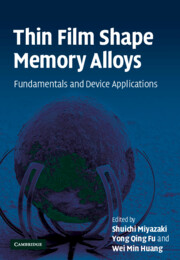Book contents
- Frontmatter
- Contents
- List of contributors
- Preface
- Abstracts of chapters
- 1 Overview of sputter-deposited TiNi based thin films
- 2 Martensitic transformation in TiNi alloys
- 3 Deposition techniques for TiNi thin film
- 4 TiNi multilayer thin films
- 5 Crystallization and microstructural development
- 6 Mechanical properties of TiNi thin films
- 7 Stress and surface morphology evolution
- 8 Ion implantation processing and associated irradiation effects
- 9 Laser post-annealing and theory
- 10 Overview of thin film shape memory alloy applications
- 11 Theory of SMA thin films for microactuators and micropumps
- 12 Binary and ternary alloy film diaphragm microactuators
- 13 TiNi thin film devices
- 14 Shape memory microvalves
- 15 Superelastic thin films and applications for medical devices
- 16 Fabrication and characterization of sputter-deposited TiNi superelastic microtubes
- 17 Thin film shape memory microcage for biological applications
- 18 Shape memory thin film composite microactuators
- 19 TiNi thin film shape memory alloys for optical sensing applications
- Index
14 - Shape memory microvalves
Published online by Cambridge University Press: 23 February 2010
- Frontmatter
- Contents
- List of contributors
- Preface
- Abstracts of chapters
- 1 Overview of sputter-deposited TiNi based thin films
- 2 Martensitic transformation in TiNi alloys
- 3 Deposition techniques for TiNi thin film
- 4 TiNi multilayer thin films
- 5 Crystallization and microstructural development
- 6 Mechanical properties of TiNi thin films
- 7 Stress and surface morphology evolution
- 8 Ion implantation processing and associated irradiation effects
- 9 Laser post-annealing and theory
- 10 Overview of thin film shape memory alloy applications
- 11 Theory of SMA thin films for microactuators and micropumps
- 12 Binary and ternary alloy film diaphragm microactuators
- 13 TiNi thin film devices
- 14 Shape memory microvalves
- 15 Superelastic thin films and applications for medical devices
- 16 Fabrication and characterization of sputter-deposited TiNi superelastic microtubes
- 17 Thin film shape memory microcage for biological applications
- 18 Shape memory thin film composite microactuators
- 19 TiNi thin film shape memory alloys for optical sensing applications
- Index
Summary
Abstract
Microvalves are a promising field of application for shape memory alloy (SMA) microactuators as they require a large force and stroke in a restricted space. The performance of SMA-actuated microvalves does not only depend on SMA material properties, but also requires a mechanically and thermally optimized design as well as a batch fabrication technology that is compatible with existing microsystems technologies. This chapter gives an overview of the different engineering aspects of SMA microvalves and describes the ongoing progress in related fields. Different valve types based on various design-material-technology combinations are highlighted. The examples also demonstrate the opportunities for emerging new applications.
Introduction
Shape memory alloys (SMAs) belong to the category of smart materials as they exhibit multi-functional properties, which can be used simultaneously to generate actuation, sensing and adaptive functions. The high energy density and favorable scaling behavior of their mechanical properties upon miniaturization make these materials particularly attractive for actuator applications in micro-dimensions.
In this realm, however, the close neighborhood of functional parts as well as fabrication constraints have a strong impact on physical properties and overall performance. In addition, the related research fields of materials development, design engineering and microtechnology are strongly interlinked and cannot be considered separately. Currently, each of these research fields faces a number of obstacles and constraints.
Despite the tremendous success in the development of SMA thin films and foils, considerable limitations due to temperature range, hysteresis and fatigue exist.
SMA microactuators usually consist of a monolithic structure with quasi-two- dimensional shape. In order to make an optimum use of the shape memory effect, homogeneous stress distributions should be generated upon loading, which requires some kind of shape optimization.
- Type
- Chapter
- Information
- Thin Film Shape Memory AlloysFundamentals and Device Applications, pp. 346 - 369Publisher: Cambridge University PressPrint publication year: 2009
- 1
- Cited by



